
Sacred Texts Legendary Creatures Symbolism Index Previous Next
Buy this Book at Amazon.com


Fictitious and Symbolic Creatures in Art, by John Vinycomb, [1909], at sacred-texts.com
According to ecclesiastical legend and tradition there are nine degrees of angelic beings. St. Dionysius relates that there are three hierarchies of angels and three orders in each; and by wise allegories each had his special mission, and they were each depicted
with certain insignia by which they were recognised in art representations, which vary somewhat in examples of different periods.
The nine choirs of angels are classed as follow, with the name of the chief of each, according to ancient legend:
|
Cherubim |
Jophiel |
| |
Dominions |
Zadchiel |
| |
Principalities |
Camiel |
|
Seraphim |
Uriel |
| |
Virtues |
Haniel |
| |
Archangels |
Michael |
|
Thrones |
Zaphkiel |
| |
Powers |
Raphael |
| |
Angels |
Gabriel |
According to A. Welby Pugin's "Glossary of Architectural Ornament and Costume," and other authorities, we learn the mediæval conception of these beings.
The following emblems are borne by angels: Flaming Swords, denoting "the wrath of God"; Trumpets, "the voice of God"; Sceptres, "the power of God"; Thuribles, or censers, the incense being the prayers of saints; Instruments of Music, to denote their felicity.
The Apparels, or borders of their robes, are jewelled with Sapphire for "celestial contemplation"; Ruby, "divine love"; Crystal, "purity"; Emerald, "unfading youth."
Archangels are the principal or chief angels, and are extraordinary ambassadors. Among these the name of Gabriel—the angel of the annunciation, the head of the entire celestial hierarchy—denotes "the power of God"; Michael, "who is like God"; Raphael, "the healing of God"; Uriel, "the fire of God."
Angel is the name, not of an order of beings, but of an office, and means messenger: wherefore angels are represented young to show their continued strength, and winged to show their unweariedness; without sandals, for they do not belong to the earth; and girt, to show their readiness to go forth and execute the will of God. Their garments are either white, to denote their purity, or golden, to show their sanctity and glory, or they are of any of the symbolical colours used in Christian Art.
A writer in the Ecclesiastical Art Review, May 1878, I. Lewis André, architect, says that "we seldom find angels clad in any other ecclesiastical vestments than the Alb (or tunic of various colours), and the amice. The Amice is sometimes like a mere loose collar; at other times it has richly embroidered Apparels (or borders), and is exactly like the priestly vestment as worn in the Middle Ages. Instead of the amice we sometimes find a scarf or cloth tied in a knot around the neck, the ends falling down in front.
"In Anne of Brittany's prayer-book is a beautiful figure of St. Michael. He has a rayed nimbus, a cross on a circlet round his head, a richly embroidered dalmatic (a long robe with sleeves partly open at the sides), and holds a sword in his left hand. The emblems of St. Michael are a crown, a sword, a shield charged with a cross of St. George, or a spear with the banner of the cross, or else with scales in his hand.
[paragraph continues] Sometimes, as at South Leigh, Oxon., he is in complete armour.
"The archangels are often figured with a trumpet in the right hand, scarfs round neck and loins; six wings, sometimes four at the shoulders and two at the hips, the legs bare from the thighs. The four archangels are frequently represented in complete armour and with swords.
The angels in the Benedictional of St. Ethelwold nearly resemble much later representations; they have wings and the nimbus or aureole, long hair and girded loins, whilst the feet are bare, as is generally the case at all periods of Gothic Art; but the characteristic drapery is loose and flowing as in the Saxon figures of saints; the wings are short and broad, the nimbus is generally rayed like the spokes of a wheel (a form seen in the work of Giotto, with whom it seems to have been a favourite). The alb or vesture has loose sleeves, and at times a mantle or cope envelops the figure; both sleeves and mantles have embroideries or apparels."
"The modern taste," says the same writer, "for giving angels pure white vesture does not appear to be derived from the Middle Ages, and certainly not from the best period when angels were clad in every brilliant colour, as a beautiful example at St. Michael's, York, shows. Here an angel swinging a golden censer has a green tunic covered with a white cloak or mantle. The nimbus is bright blue, and the wings have the upper parts yellow, and are tipped
with green. At Goodnestowe church, St. Michael has a deep crimson tunic, a white mantle edged with a rich gold border, green wings, and a light crimson nimbus," and mention is here made of the white vesture of the angel at the Sepulchre, and that nowhere else
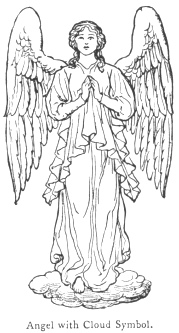 |
"Often the angels’ wings are feathered red and blue alternately, as on the pulpit at Cheddar, Somerset. Sometimes the wings have feathers like those of a peacock, on the Chapter House, Westminster; round the 'Wall Arcade, angels have their wings inscribed with a text on every feather. This corresponds with the French 'hours' of Anne of Brittany, where an angel (St. Gabriel) wears a mantle with a text running along the border."
It was not uncommon to represent angels in carving and stained glass in the latter part of the fifteenth century as feathered all over like birds.
Cloud Symbol of the "Sky" or "Air."—Artists of the Mediæval and Renaissance periods, following classical authority, employed the cloud symbol of the sky or
air in their allegories and sacred pictures of divine persons, saints, and martyrs, to denote their divine or celestial condition, as distinguished from beings "of the earth—earthy." The adoption of the little cloud underneath the feet, when the figure is not represented flying, naturally suggested itself as the most fitting emblem for a support, and avoided the apparent incongruity of beings in material human shape standing upon nothing. The suggestion of the aerial support here entirely obviates any thought of the outrage on the laws of gravity.
Another distinguishing attribute is the Nimbus—an emblem of divine power and glory—placed behind or over the head. The crown is an insignia of civil power borne by the laity; the nimbus is ecclesiastical and religious. The pagans were familiar with the use of the nimbus, which appears upon the coins of some of the Roman Emperors. It was widely adopted by the Early Christian artists, and up till the fifteenth century was represented as a circular disc or plate behind the head, of gold or of various colours, and, according to the shape and ornamentation of the nimbus, the elevation or the divine degree of the person was denoted. It was displayed behind the heads of the Persons of the Trinity and of angels. It is also worn as a mark of honour and distinction by saints and martyrs. At a later period, when the traditions of early art were to some extent laid aside, i.e., from the fifteenth century until towards the end of the seventeenth century, as M. Dideron informs us,
a simple unadorned ring, termed a "circle of glory," "takes the place of the nimbus and is represented as hovering over the head. It became thus idealised and transparent, showing an outer circle only; the field or disc is altogether omitted or suppressed, being
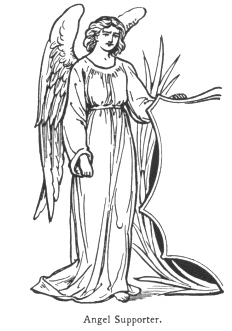 |
Although the forms of angels are of such frequent occurrence in Mediæval Art they seem to abound more especially in the fifteenth century. Angels are seen in every possible combination, with ecclesiastical and domestic architecture, and form the subject of many allusions in heraldry. They are frequently used as supporters.
Charles Boutell, M.A., "English Heraldry,"
p. 247, says, regarding angels used as supporters to the armorial shield: "The introduction of angelic figures which might have the appearance of acting as guardian angels’ in their care of shields of arms, was in accordance with the feelings of the early days of English heraldry; and, while it took a part in leading the way to
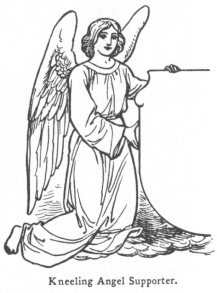 |
Figures of angels holding shields of arms, each figure having a shield in front of its breast, are frequently sculptured in Gothic churches. They appear on seals, as on that of Henry of Lancaster about 1350, which has the figure of an angel on each side of it. The shield of Richard II. at Westminster Hall, bearing the arms of France ancient and England quarterly, is supported by angels, which, if not
rather ornamental than heraldic, were possibly intended to denote his claim to the crown of France, being the supporters of the Royal arms of that kingdom. Upon his Great Seal other supporters are used. There are also instances of the shield of Henry VI. being supported by angels, but they are by some
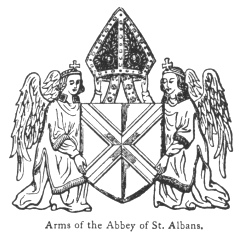 |
The supporters of the King of France were two angels standing on clouds, all proper, vested with taberts of the arms, the dexter France, the sinister Navarre, each holding a banner of the same arms affixed to a tilting-spear, and the cri de guerre or motto, "Mont-joye et St. Denis." The shield bears the impaled arms of France and Navarre with several orders of knighthood, helmet, mantling and other accessories, all with a pavilion mantle.
Although Francis II., Charles IX., Henry III. and IV. and Louis XIII. had special supporters of their arms, yet they did not exclude the two angels of Charles VI., which were considered as the ordinary supporters of the kingdom of France. Louis XIV., Louis XV. and Louis XVI . never used any others.
Verstegan quaintly says that Egbert was "chiefly moved" to call his kingdom England "in respect of Pope Gregory changing the name of Engelisce into Angellyke," and this "may have moved our kings upon their best gold
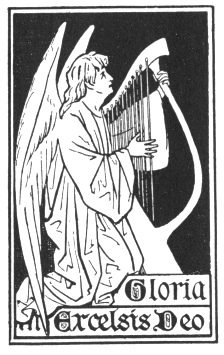 |
The gold coin was named from the fact that on one side of it was a representation of the archangel in conflict with the dragon (Rev. xii. 7). The reverse had a ship. It was introduced into England by Edward IV. in 1456. Between his reign and that of Charles I. it varied in value from 6s. 8d. to 10s.
43:* "Restit. of Decayed Intell. in Antiq." p. 147.